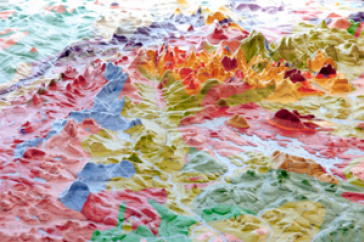UNH Expert Available to Discuss Upcoming Perseid Meteor Shower

New Hampshire's White Mountains, returned to their rightful height, are a highlight of the newly restored historical relief map of Northern New England at the University of New Hampshire's James Hall. Credit: Lisa Nugent, UNH Photographic Services.
DURHAM, N.H. - Professor Eberhard Möbius of the University of New Hampshire's Space Science Center is available to discuss the Perseid meteor shower, which will be visible starting tonight. The best time to see the "shooting stars" will be after midnight through the pre-dawn hours of Friday, August 13. Among the strongest of the annual meteor showers, the Perseids can yield a maximum of 90 or 100 meteors per hour under the right conditions.
Möbius is a professor of space plasma physics at the UNH Institute for the Study of Earth, Oceans, and Space and the physics department. He is expert in the acceleration of ions in the Earth's magnetosphere, in interplanetary space, and in solar flares, as well as the interaction of interstellar gas with the solar wind and the study of the local interstellar medium. He teaches the introductory astronomy course at UNH, which on occasion has included early morning field trips to witness the Leonid meteor shower. The Leonids occur every November as Earth plows through the dust trail of comet Tempel-Tuttle.
The Perseid meteor shower occurs every August as the Earth passes through the leftover dust from comet Swift-Tuttle, which was discovered nearly 150 years ago and was most recently observed in 1992. It takes 130 years for the comet to circle the Sun. With each pass it leaves a fresh debris trail.
Meteors are the visible effects of a bombardment of the upper atmosphere with the dust particles, and occasionally larger debris, left from the passing comet. Because of the high speed with which they enter the atmosphere - up to 140,000 miles per hour - all the small particles and most of the larger ones burn up completely in the air. Generally people see the fiery streaks - the shooting stars - hurtling across the sky but on occasion the larger particles, known as "fireballs", burn brightly and may even produce an audible sound if passing close to the observer. More details on the Perseids can be found at the spaceweather.com website.
The Institute for the Study of Earth, Oceans, and Space (EOS) is UNH's largest research enterprise, receiving approx. $38 million each year in research support from NASA, NOAA, NSF and other federal agencies.
The University of New Hampshire, founded in 1866, is a world-class public research university with the feel of a New England liberal arts college. A land, sea, and space-grant university, UNH is the state's flagship public institution, enrolling 12,200 undergraduate and 2,200 graduate students.
-30-
Eberhard Möbius can be reached at 603-862-3097 and mailto:eberhard.moebius@unh.edu"
Latest News
-
November 6, 2025
-
November 5, 2025
-
October 24, 2025
-
October 8, 2025
-
October 2, 2025
















































